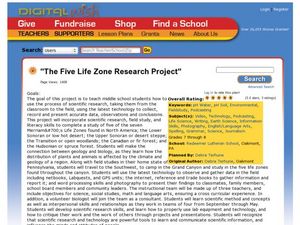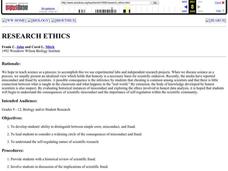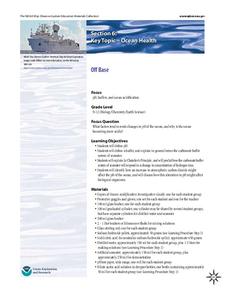Curated OER
Research Ethics
Young scientists discuss the results of carelessness during experimentation and the temptation to misrepresent findings. These activities are intended to develop the ability to identify scientific error, misconduct, and fraud. Use this...
Curated OER
Why Muscle Biology?
Students research and define a muscle biology research question and organize an experiment to address the question utilizing either NADH staining or acid buffering. They analyze data as well as draw conclusions about their research....
Curated OER
Human Cloning: Is it Biological Plagiarism?
Is cloning good or harmful? Help your class understand the risks and benefits as they read, research, and discuss human cloning. Individuals form teams, research information, and present to the class before concluding with an in-depth...
Curated OER
Honors Biology E3 Project Instructional Plan
Ninth graders evaluate the use of radiation in medical procedures. In this biology instructional activity students compare and contrast meiosis and mitosis. They research the different applications of radiation.
Curated OER
Biology E3 Project Instructional Plan
Ninth graders design a device to treat aneurism. In this biology lesson, 9th graders create a polymer in the lab and explain its uses. They identify the different diseases affecting the circulatory system.
Curated OER
Biotechnology Laboratory Research
Students participate in an extended laboratory research to experience how scientific information is obtained, upon which we build scientific knowledge and understanding.
Curated OER
Human Origins: The Prehistoric Human Race
When it comes to the origin of the human species high schoolers are full of misconceptions. Clear up the hominid confusion with this evolutionary activity focused on assisting students in understanding prehistoric man and his family...
NOAA
Watch the Screen!
Can a sponge cure cancer? Life science pupils visit the drugstore under the sea in the fifth activity of six. Working groups research the topic then get hands-on experience by testing the inhibiting effects of several plant extracts...
Howard Hughes Medical Institute
Gorongosa: Making Observations Activity
Do you have young scientists wanting to make new discoveries rather than just completing the same experiments? Young scientists use their observational skills to identify animals and patterns in animal behavior. Through tracking...
Curated OER
The Five Life Zone Research Project
Students study five of the seven life zones in North America. In this journalism lesson students use the Scientific Method working in teams. They use lab equipment and technology to create a presentation on five of the seven life zones...
Curated OER
The Human Genotype
Six different chromosome activites introduce biology aces to heredity, chromosomal abnormalities, sex-linked traits, and the human genome. The hands-on activites are fairly simple for the teacher to prepare and will prove to be both...
Curated OER
Genetically Modified Food (GMF)
Explore genetically modified foods through various experiments. In this biology lesson, students discuss the safety issues related to GMF's. They conduct a PCR analysis to identify the presence of genetic modification.
Curated OER
AP Biology Lesson Outline
Twelfth graders research about the different careers in bioengineering. In this biology lesson, 12th graders identify the different stages in the cell cycle. They discuss the pros and cons of using radiation.
Curated OER
AP Biology Lesson Outline
Ninth graders research the different field of bioengineering. In this biology lesson, 9th graders differentiate meiosis and mitosis. They discuss the pros and cons of using radiation in medical diagnostics.
Curated OER
Research Ethics
Young scholars develop an ability to distinguish between simple error, misconduct and fraud. Students are lead to consider a widening circle of the consequences of misconduct and fraud. They expand their knowledge on the...
Curated OER
Mapping the Human Genome
Students study DNA and how it was discovered. In this biology instructional activity students see the effects of mapping the human genome would have.
NOAA
Off Base
How does carbon dioxide affect the world's oceans? The final installment in a series of six lessons has pupils research ocean acidification, then conduct an experiment to witness the delicate balance that exists in our seas. Materials...
Tech Museum of Innovation
Analogous Models
What goes into a museum display? A secondary-level STEM project prompts groups to design a museum display for the Tech Museum of Innovation. They create an analogous, interactive model illustrating a science concept to complete the...
Curated OER
Design Your Own Biological Experiment
Young scholars work together to research a topic of interest to them. They form hypothesis and complete experiments testing them. They present their findings to the class.
Curated OER
Nitrogen Fixation, OR What a Gas!
Students gain skill in the design, implementation, and reporting of a scientific research project using the scientific method. They set up an experiment to determine the effect of adding the Rhizobium bacteria to one group of legume...
Curated OER
Fisheries Project
Young scholars explore biology by completing a fishing worksheet. In this commercial fishery lesson, students identify the process of taking mass fish from the ocean and delivering them to eateries while discussing the negative aspects....
Curated OER
Improving Literacy in the Biology Classroom via Genetic Disorders
Students read, write and reflect on Science articles, this approach will promote both literacy and critical thinking skills. Critical thinking skills learned in the science classroom from these activities will impact students in many...
Curated OER
The Role of Amyloid in Alzheimer's Disease
Students explore amyloid proteins through a series of experiments. In this biology lesson, students explain the causes of Alzheimer's disease. They identify common symptoms related to this condition.
Curated OER
Seeds of Wetland Life
Students participate in several activities on seed exploration. In this biology lesson plan, students classify seeds according to their dispersal method. They explain the different adaptations plant have to disperse their seeds.























